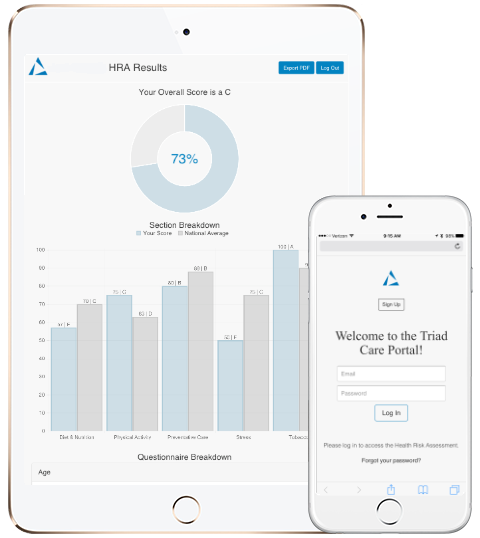Our Solution
Risk Stratification
Triad Care combines real-time biometric screening data with qualitative results from our custom health risk assessment to identify risks and stratify clients into the most appropriate course of care. Our thorough algorithm ensures clients are matched with the most effective providers to maximize healthcare outcomes as well as employee engagement.
Preventative Wellness
Triad Care prioritizes prevention through a comprehensive range of services designed to promote healthy lifestyles and lasting behavior change. Our registered dietitians provide customized nutritional counseling with an emphasis on individual preferences and real-life solutions. We also offer immunization clinics, activity challenges, smoking cessation coaching, and group classes.
Onsite Clinic
Triad Care provides onsite health clinics for groups of clients who would benefit from auxiliary services. Our team of nurse practitioners and physician assistants work in collaboration with the wellness team to provide primary care, acute and episodic care, disease management, DOT physicals, agility testing, and lab work as appropriate.
Wellness Platform
Our interactive online platform and mobile app allow participants to complete assessments, upload information, schedule appointments, review health resources and view biometric data. This easy to use tool serves as a hub for all health and wellbeing initiatives. Our platform is completely customizable allowing us to tailor the experience for each of our customers.
Disease Management
Triad Care transforms the management of chronic conditions by minimizing the barriers to treatment through our healthcare concierge model that consistently improves clinical outcomes. Our skilled and personable clinical pharmacists and registered dietitians offer disease education, medication therapy management, and medical nutritional therapy to help clients optimize self-care.
Data Analytics
At Triad Care, we monitor the effectiveness of our program by both clinical outcomes and financial return on investment. Our innovative analytics allow us to measure changes in risk strata among clients, as well as identify qualitative trends and opportunities for further improvements to assist employers in their efforts to control healthcare spending.


